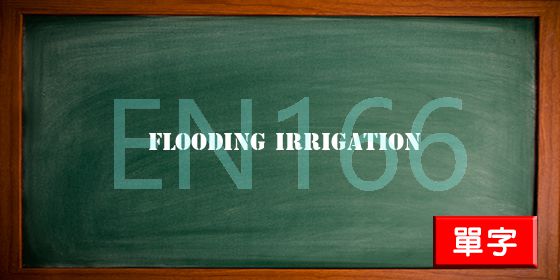flooding irrigation 漫灌。
漫灌。 “flooding“ 中文翻譯: n. 1.泛濫;灌溉。 2.充溢。 3.【化學】溢流;( ...“irrigation“ 中文翻譯: n. 1.灌溉;水利。 2.【醫學】沖洗(法),〔pl. ...“irrigation by flooding“ 中文翻譯: 漫灌“borderstrip flooding irrigation“ 中文翻譯: 分區漫灌“check-flooding irrigation“ 中文翻譯: 分畦漫灌“flooding irrigation method“ 中文翻譯: 漫灌法“free flooding irrigation“ 中文翻譯: 自由漫灌“irrigation by surface flooding“ 中文翻譯: 地面淹灌“wild flooding irrigation“ 中文翻譯: 大片漫灌; 濫灌“wild flooding irrigation method“ 中文翻譯: 大片漫灌法“flooding“ 中文翻譯: n. 1.泛濫;灌溉。 2.充溢。 3.【化學】溢流;(分餾時的)液阻現象;(油漆干燥或加熱時的)變色。 4.【醫學】血崩;產后出血。 “flooding into“ 中文翻譯: 蜂擁到....“irrigation“ 中文翻譯: n. 1.灌溉;水利。 2.【醫學】沖洗(法),〔pl.〕沖注洗劑。 bring the farmland under irrigation使農田水利化。 an irrigation canal [channel] 灌溉渠。 an irrigation project 灌溉計劃。 adj. -al ,-ist n. 灌溉者,水利專家。 “alcohol flooding“ 中文翻譯: 醇類驅油“angle of flooding“ 中文翻譯: 浸水角“area flooding“ 中文翻譯: 區域淹沒“artificial flooding“ 中文翻譯: 漫溉; 人為浸水“backup flooding“ 中文翻譯: 支持注水“basin flooding“ 中文翻譯: 畦田漫灌“bosh flooding“ 中文翻譯: 爐腹液泛現象“caustic flooding“ 中文翻譯: 堿水驅油“cellar flooding“ 中文翻譯: 單井注采地窖油“check flooding“ 中文翻譯: 分畦淹灌; 分區漫灌; 因過高水面淹沒“check-flooding“ 中文翻譯: 分畦漫灌“chemical flooding“ 中文翻譯: 化學攻法; 化學劑驅
floodlight |
|
Rice , one of the three major crops in the ningxia irrigation area of yellow river . is widely planted . the traditional irrigation techniques of rice are flood irrigation and deep storage . which need more water consumption and have higher application volumes . with the increase in population , the development of industrial and agricultural production and the uniform catchment agreement for the water resource of yellow river , the supplying and demand contradiction of the water resources in ningxia is more evident , then drang is presented for developing water - saving and efficient agriculture 近年來,水稻節水控灌技術在寧夏引黃灌區推廣后取得了顯著的經濟和社會效益。但如何確定節水控灌技術是現有條件下適合寧夏引黃灌區特別是鹽堿耕地的水稻種植先進灌溉技術,如何確定鹽堿地的淋洗水量及灌水模式,探索節水控灌技術在鹽堿地的適應性,研究水稻節水控灌技術增產機理,對進一步推廣水稻節水控灌技術及改良、開發鹽堿地和鹽堿荒地具有重要意義。 |
|
In recent years , the water - saving and control irrigation technique of rice has diverted from plot experimental and demonstration to lare scale . and has got remarkable economic and social benefits . amed at the characteristics of this irrigation area , optimal selection for water - saving techniques of rice , deciding the amout of leaching water and irrigation modles , investigating the adaptability of the water - saving and control irrigation technique in saline land . studying the increase in production mechanism of the technique are important to extend the technique , to better and develop saline land as well as slick spots . according to the results of field experiments , optimization study was conducted on the water - saving irrigation technique of rice in saline land , the effects of different water - saving irrigation techniques on the physiological indexes and yield of rice were systematically analyzed . by using mutiplepurpose fuzzy optimization method , better . water - saving irrigation technique was selector out , that is . the control irrigation technique in rice . the mechanism of it was analyzed from the aspect of the physiological and ecological saving water of rice to provide the implemental process and technical point ; throgh the quantitive analysis and comparision on control irrigation and control class ( flood irrigation ) , high production and quality mechanism of the technique was analyzed in terms of physiology indexes of rice , the variation of soil moisture , the pest resistance and the lodge resistance , the change of soil temperature in paddy fields . the yield constitutive factors , the quality of rice and so on . in saline land . control irrigation and intermittent leaching modles were adopted to validate the adaptability of the technique in irrigation of rice in saline land , to analyze rice ' s physiological - ecological indexes and the change of soil salt content under the conditions of control irrigation leaching of rice and and to provide control irrigation and combined modle of intermittent leaching to adapt to different conditions 本文從試驗及試驗資料入手,取得以下主要成果和結論:對鹽堿地水稻節水灌溉技術進行優化研究,系統地分析了不同節水灌溉技術對水稻生理指標及產量的影響,采用了多目標模糊優化的方法,對灌水技術進行綜合評判,優選了節水灌溉技術,論證該地區宜采用水稻控制灌溉技術;闡述控灌技術通過調節和控制水稻的需水規律,降低水稻高產情況下的無效水量消耗,從水稻生理、生態節水兩方面分析了控灌技術節水機理,針對性地總結出水稻各生育期實施節水控灌技術的步驟及技術要點;通過控灌與淹灌的定量對照比較,從根系、莖蘗、冠層葉片及綠葉動態到株高,土壤水分變化,抗病蟲害、抗倒伏能力,稻田土溫變化,產量構成因素及稻米品質等諸多方面進行動態比較,分析控灌技術高產優質機理;在鹽堿稻地采用控制灌溉+間歇淋洗模式,跟蹤測試田間水鹽變化狀況,驗證控制灌溉技術在鹽堿地區水稻灌溉中應用的適應性,通過分析水稻控制灌溉淋洗條件下水稻生理生態指標,提出優化控制灌溉+間歇淋洗組合模式,為進一步在高礦化度地區試驗水稻控灌技術奠定基礎。 |
|
Three wheat cultivars , yannong 19 ( with spread plant type ) , jimai 20 ( with semi - spread plant type ) and taishan 23 ( with erect plant type ) , were used to investigate the wue ( water use efficiency ) change under raised bed planting with furrow irrigation and conventional flat planting with flood irrigation 摘要為尋找提高小麥水分利用效率的途徑,以株型擴張品種煙農19 、株型緊湊品種泰山23和株型半擴張品種濟麥20為材料,比較研究了壟作(小水溝內滲灌)和平作(大水漫灌)兩種栽培模式下小麥的水分利用效率。 |
|
The amount of nitrogen leached was increased with the increasing amount of water applied . and compared to the treatment of fertilizer added as flooding irrigation ( fif ) , the treatment of fertilizer added in drip irrigation ( dif ) significantly decreased the nitrogen leached 氮素淋溶量隨灌水量的增加而增加;在淋失的n素形態中,以尿素態氮為主,其次為硝態氮,銨態氮的淋失量最低。 |

